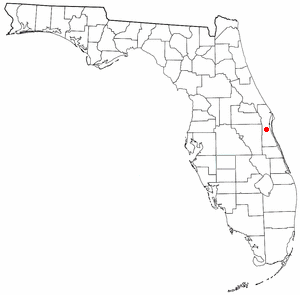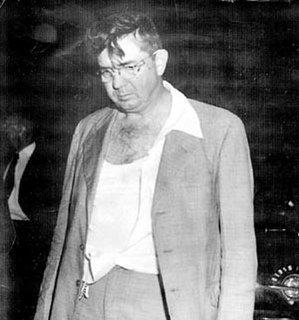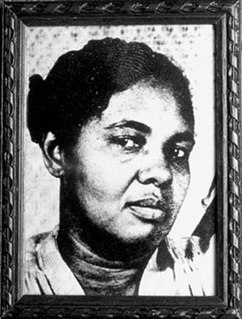
Moore Memorial Park and Cultural Center is a historic site in Mims, Florida. The site, which was the home of civil rights leader Harry T. Moore, now houses a museum, conference center and park. [1]

Moore Memorial Park and Cultural Center is a historic site in Mims, Florida. The site, which was the home of civil rights leader Harry T. Moore, now houses a museum, conference center and park. [1]
Harry T. Moore was a teacher and civil rights leader who organized a variety of initiatives in Florida. He founded the first chapter of the NAACP in Brevard County and in 1938, sued the school district in order to receive equal pay for black teachers. Gilbert v. Board of Public Instruction of Brevard County reached the Florida Supreme Court, where the court ruled in favor of the district. [2]
On December 25, 1951 Moore and his wife were assassinated when a bomb was placed under their house. They are believed to be the first civil rights activists to be assassinated during the movement. [3] [4]
In 1994, Brevard County bought the land where the Moore's house once stood. [5] A nonprofit organization was organized to raise money for the site, and in 2004 the cultural complex was dedicated. The cultural complex includes a museum [6] and a replica of their home. [7]
The grounds of the center also include a 12 acre landscaped park with paths, reflecting pool, fountain, and gazebo. [8]
The Harry T. & Harriette V. Moore Memorial Park & Museum is an official landmark site of the United States Civil Right Trail. [1]

Brevard County is a county located in the east central portion of the U.S. state of Florida. As of the 2020, the population was 606,392, making it the 10th-most populated county in Florida. The official county seat has been located in Titusville since 1894. Brevard County comprises the Palm Bay–Melbourne–Titusville, FL Metropolitan Statistical Area. It is located along the east Florida coast and bordered by the Atlantic Ocean.

Mims is a census-designated place (CDP) in Brevard County, Florida. The population was 7,058 at the 2010 United States Census. It is part of the Titusville, Florida Metropolitan Statistical Area.

The National Civil Rights Museum is a complex of museums and historic buildings in Memphis, Tennessee; its exhibits trace the history of the civil rights movement in the United States from the 17th century to the present. The museum is built around the former Lorraine Motel, which was the site of the assassination of Martin Luther King Jr. in 1968; King died at St. Joseph's Hospital. Two other buildings and their adjacent property, also connected with the King assassination, have been acquired as part of the museum complex.

Viera is an affluent, master-planned community located in the central coastal region of Brevard County, Florida. It is part of an unincorporated section adjacent to the Melbourne, Florida area. For census purposes, it is divided between the Census Designated Places of Viera East and Viera West. At the 2020 census, Viera East had a population of 11,687, while Viera West had a population of 16,688.

Harry Tyson Moore was an African-American educator, a pioneer leader of the civil rights movement, founder of the first branch of the National Association for the Advancement of Colored People (NAACP) in Brevard County, Florida, and president of the state chapter of the NAACP.

Willis Virgil McCall was sheriff of Lake County, Florida. He was elected for seven consecutive terms from 1944 to 1972. He gained national attention in the Groveland Case in 1949. In 1951, he shot two defendants in the case while he was transporting them to a new trial and killed one on the spot. Claiming self-defense, he was not indicted for this action. He also enforced anti-miscegenation laws and was a segregationist.

The Canaveral National Seashore (CANA) is a National Seashore located between New Smyrna Beach and Titusville, Florida, in Volusia and Brevard Counties. The park, located on a barrier island, was created on January 3, 1975, by an act of Congress. The park is split between Brevard and Volusia counties, with 9 miles of the seashore in Brevard County, and 15 miles of the seashore in Volusia County. CANA consists of 24 miles of beaches, dunes, mangrove wetlands, and a large portion of the Mosquito Lagoon. The Canaveral National Seashore is also the longest expanse of undeveloped land along the East Coast of Florida. The Canaveral National Seashore is home to more than 1,000 plant species and 310 bird species. CANA occupies 57,662 acres (23,335 ha). There are 3 major beach sections in the seashore. The southern section is Playalinda Beach, the middle section is Klondike Beach, and the northern section is Apollo Beach.

The Fort Walton Mound (8OK6) is an archaeological site located in present-day Fort Walton Beach, Florida, United States. The large platform mound was built about 850 CE by the Pensacola culture, a local form of the Mississippian culture. Because of its significance, the mound was designated a National Historic Landmark in 1964.
The Highwaymen, also referred to as the Florida Highwaymen, are a group of 26 African American landscape artists in Florida. Two of the original artists, Harold Newton, and Alfred Hair, received training from Alfred “Beanie” Backus. It is believed they may have created a body of work of over 200,000 paintings. They challenged many racial and cultural barriers. Mostly from the Fort Pierce area, they painted landscapes and made a living selling them door-to-door to businesses and individuals throughout Florida from the mid-1950s through the 1980s. They also sold their work from the trunks of their cars along the eastern coastal roads.

The Robert Russa Moton Museum is a historic site and museum in Farmville, Prince Edward County, Virginia. It is located in the former Robert Russa Moton High School, considered "the student birthplace of America's Civil Rights Movement" for its initial student strike and ultimate role in the 1954 Brown v. Board of Education case desegregating public schools. It was designated a National Historic Landmark in 1998, and is now a museum dedicated to that history. In 2022 it was designated an affiliated area of Brown v. Board of Education National Historical Park. The museum were named for African-American educator Robert Russa Moton.
Brevard County, Florida provides a number of unique services to help the aged, juveniles, the physically and mentally handicapped, and minorities.

The following is an alphabetical list of articles related to the U.S. state of Florida.

Harriette Vyda Simms Moore was an American educator and civil rights worker. She was the wife of Harry T. Moore, who founded the first branch of the National Association for the Advancement of Colored People (NAACP) in Brevard County, Florida. The murder of the Moores was the first assassination to happen during the Civil Rights Movement and the only time both a husband and a wife were killed for their activism.

The St. Augustine movement was a part of the wider Civil Rights Movement, taking place in St. Augustine, Florida from 1963 to 1964. It was a major event in the city's long history and had a role in the passage of the Civil Rights Act of 1964.
The History of Brevard County can be traced to the prehistory of native cultures living in the area from pre-Columbian times to the present age. Brevard County is a county in the U.S. state of Florida, along the coast of the Atlantic Ocean. The geographic boundaries of the county have changed significantly since its founding. The county is named for Judge Theodore W. Brevard, an early settler, and state comptroller, and was originally named St. Lucie County until 1855. The official county seat has been located in Titusville since 1894, although most of the county's administration is performed from Viera.

Eastern Florida State College, formerly Brevard Community College, is a public college in Brevard County, Florida. It is a member of the Florida College System and has campuses in Cocoa, Melbourne, Palm Bay, and Titusville, as well as a Virtual Campus.
The Civil War Trust's Civil War Discovery Trail is a heritage tourism program that links more than 600 U.S. Civil War sites in more than 30 states. The program is one of the White House Millennium Council's sixteen flagship National Millennium Trails. Sites on the trail include battlefields, museums, historic sites, forts and cemeteries.
Carver Junior College, in Cocoa, Florida, was established by the Brevard County Board of Public Instruction in 1960 to serve black students, at the same time that it founded Brevard Junior College, now Eastern Florida State College, for white students. It was named for the black agricultural researcher George Washington Carver. Like 10 of Florida's other 11 black junior colleges, it was founded as a result of a 1957 decision by the Florida Legislature to preserve racial segregation in education, mandated under the 1885 Constitution that was in effect until 1968. More specifically, the Legislature wanted to show, in response to the unanimous Supreme Court decision mandating school integration, that the older standard of "separate but equal" educational facilities was still viable in Florida. Prior to this legislative initiative, the only publicly funded colleges for negro or colored students were Florida A&M University, in Tallahassee, and Booker T. Washington Junior College, in Pensacola.

Harry T. Moore and his wife, Harriette V. S. Moore, were pioneer activists and leaders of the early Civil Rights Movement in the United States and became the first martyrs of the movement. On the night of Christmas, December 25, 1951, a bomb that had been planted under the bedroom floor of the Moores' home in Mims, Florida, exploded. They had celebrated their 25th wedding anniversary earlier that day. Harry died in the ambulance in transit from the attack, and Harriette died from her injuries nine days later, on January 3, 1952. Their death was the first assassination of any activist to occur during the Civil Rights Movement and the only time that a husband and wife were killed during the history of the movement.

Cocoa Junior High School is a historic school building in Cocoa, Florida. Built in 1923-24, it is one of the oldest remaining Rosenwald Schools in Florida. After the school closed in 1954, the building served as a community center and later as an African-American history museum.